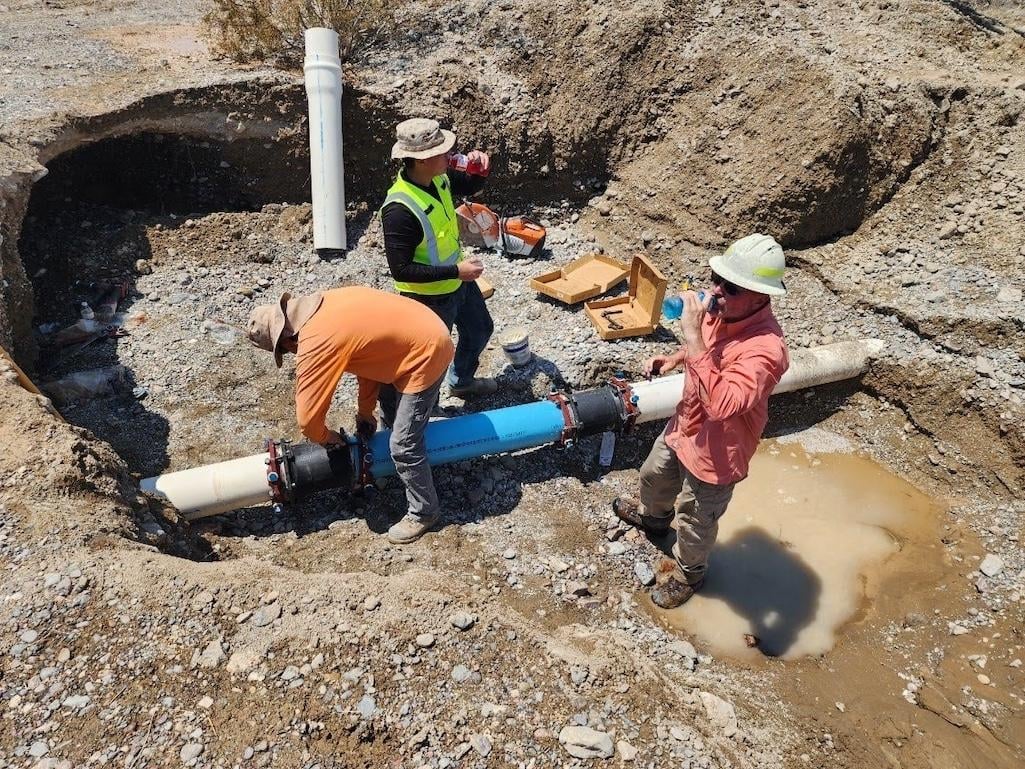
Park Advocates: Time To Build Momentum For GAOA Reauthorization
By Kurt Repanshek
August 11, 2024

In the four years since President Trump signed the Great American Outdoors Act into law, upwards of $5 billion has been spent by the National Park Service to rebuild pothole-riddled roads, rehabilitate weary and worn-out buildings, and to repair water systems.
Hiking trails have been rebuilt, HVAC systems replaced, new bridges are replacing decrepit spans, and even replicas of the huts the Continental Army hastily erected in central New Jersey almost 250 years ago have been reconditioned. Even one mile of underground pathway at Mammoth Cave National Park has been improved with GAOA funding.
And yet, the dollar-value of the Park Service’s maintenance backlog hasn’t gone down, according to the Congressional Research Service (CRS).
When the GAOA was passed by Congress in 2020, the cost of deferred maintenance (DM) across the National Park System was pegged at about $12 billion. That number grew to around $22 billion in 2021 when the Park Service recalculated how to value DM, and at the end of Fiscal 2023 last September the agency estimated the cost of the backlog at $23.3 billion.
The numbers game swings on an array of factors, from new approaches to estimating DM (done both in FY21 and FY22), inflation, projects that get canceled or new projects that arise, as well as previously undiscovered issues that arise once a project gets started.
Regardless of where the DM number stands, the GAOA has funded scores of projects across the National Park System that have made parks more safe for visitors and enhanced the visitors’ experience.
“The Park Service has just been doing an extraordinarily great job of getting projects up and running, from planning to design to construction,” Kristen Brengel, senior vice president for government affairs for the National Parks Conservation Association, said during this week’s podcast from the Traveler. “They’re spending the money quickly, which is fantastic, because it means parks are getting fixed right now and cutting ribbons and visitors are going to be enjoying the new roads and bridges and campsites and facilities. They’ve just done a fantastic job spending the money.”
Eric Stiles, president and CEO of Friends of Acadia, which works to benefit Acadia National Park, agreed.
“When you look at national parks, it’s one of the few things that government does that has a huge impact on the private sector,” said Stiles. “So, when you look at the two major projects at Acadia National Park, the maintenance building and over at Schoodic (Peninsula) the wastewater (treatment plant), that’s money going to good local firms. These are big projects going out the door to local firms. Good-paying, living-wage jobs to enhance the visitor experience and protect the park, which is the largest employer in Downeast Maine.”
Mission Impossible?
Whether the Park Service can ever wipe out deferred maintenance is certainly debatable when you consider the size of the National Park System, aging infrastructure, and Congress’s vagaries when it comes to spending.
In its report last month on the deferred maintenance dilemma, the CRS pointed to the challenges the Park Service faces.
“One key driver of growth in NPS maintenance needs has been the increasing age of agency infrastructure. Many NPS assets—such as visitor centers, roads, and other assets—were constructed by the Civilian Conservation Corps in the 1930s or as part of NPS’s Mission 66 infrastructure initiative in the 1950s and 1960s. As these structures have reached or exceeded the end of their anticipated life spans, unfunded costs of repair or replacement have contributed to the DM backlog. Further, [Park Service] officials point out that as time goes by and needed repairs are not made, the rate at which such assets deteriorate is accelerated and can result in a spiraling burden,”‘ the research entity noted.
“Some units, such as Yellowstone National Park and Grand Canyon National Park, are older parks whose infrastructure was largely built in the mid-20th century. Some units, such as Gateway National Recreation Area, Golden Gate National Recreation Area, and the National Mall and Memorial Parks, are located in or near urban areas and may contain more developed infrastructure than some more remotely located parks,” it added. “The costs of labor and materials to execute DM projects also may be higher in these urban areas. Three of the units with the highest estimated DM are national parkways, consistent with the relatively high portion of NPS’s overall DM that is related to road needs.”
Fueling the GAOA are royalties from energy development on federal lands. The GAOA receives yearly deposits of amounts equal to 50 percent of all federal energy development revenues, up to an annual cap of $1.9 billion. The Park Service receives 70 percent of that pot of money, some $1.33 billion a year, with the rest heading to the U.S. Forest Service, Bureau of Land Management, Fish and Wildlife Service, and Bureau of Indian Education.
Still, the $6.5 billion the Park Service is expected to realize over five years from GAOA can seem miniscule when placed not only against the total estimated DM costs, but even against individual park’s DM estimates.
Yellowstone in FY23 had an estimated $1.5 billion backlog, Yosemite National Park’s was estimated at $1.27 billion, the National Mall and Memorial Parks in the District of Columbia nearly $1 billion, Gateway National Recreation Area in the greater New York-New Jersey metropolitan area also nearly $1 billion, and Grand Canyon National Park more than $800 million.
Those five units of the park system alone account for more than $5.5 billion of the backlog.
Success Stories
The pressing DM needs across the park system, along with the accomplishments made so far through the first four years of the Great American Outdoors Act, have NPCA’s Brengel, FOA’s Stiles, and Phil Francis, chair of the Coalition to Protect America’s National Parks, advocating for Congress to reauthorize the act before it is set to end in September 2025.
Francis, who spent more than four decades with the Park Service, including many years as superintendent of the Blue Ridge Parkway, said the backlog got so backed up because the Park Service was never able to stay on top of the growing number of projects.
“Some projects are put on the backburner just because, prior to the Great American Outdoors Act, there wasn’t the money, and so there was a lot of competition,” he explained. “And there was this huge, long list of needs, you know, and some of those needs were really big.”
Roadwork on the Blue Ridge Parkway has long been a huge expense, said Francis, including a single project with a billion-dollar price tag.
“One of the comments that our coalition has made is a lot of the smaller parks were left out in the first-round of funding,” he added a bit later. “But I understand why they funded mega projects earlier. It makes sense to demonstrate to the Congress that the Park Service is capable of spending the money wisely and spending big chunks of money. If you look at their projects now, as time has gone by, there’s more and more smaller projects in line.”
Brengel called the speed at which the Park Service is utilizing GAOA funding “impressive.”
“It’s amazing how much dirt is flying right now. If I were Congress and looking at an agency and saying, ‘Are they effectively moving these projects forward?’ They are moving them forward,” said Brengel. “Very, very well.
“…I think this is a winning program. I think this is so good for the national and local economies,” she added. “It’s just a winner for Congress to keep investing in. The $6.5 billion that ultimately will be spent in this first five years of funding is doing so much good. Two-hundred-and-fifty parks have projects in them. I mean, talk about trying to spread the money out as far as you can. Over 400 major projects are getting accomplished right now. When I go to visit parks, the superintendents are always quick to point out to me, either a project that was funded through the Great American Outdoors Act or a project that is getting done because the Great American Outdoors Act freed up money for them to get another project done.”
While Stiles declined to speculate whether Maine’s congressional delegation is ready to reauthorize the GAOA, he was of the opinion that “it seems to be the one issue that both parties agree on and agree on with great gusto, is supporting our national parks.”
“Regardless of how you feel on a whole variety of issues that are kind of bubbling up these days, to me, national parks are lingua franca,” a common language between politicians, he said. “It’s one thing that folks can and do continue to walk across the aisle and work with one another on.”
How true that is should become obvious later this year, as the U.S. House has passed out a rather austere FY25 appropriations bill for the Interior Department, one that would cut the Park Service’s budget by roughly $200 million, according to NPCA. The Senate Appropriations Committee, meanwhile, approved funding levels that would increase NPS staffing by 450 positions and provide “increases at parks across the country to more effectively and impactfully manage, preserve and interpret the stories that shape our nation’s collective history and culture,” said the park advocacy group.
How the two chambers resolve the differences remains to be seen.
“The No. 1 question I get from our donors is, ‘What is Congress bringing to the table?’” said Stiles. “The cuts and vision in the House, in my opinion, are reckless. I’m much more bullish on the Senate version. As you look at the role of philanthropy in this space, if House members simply think that’s going to be offset by philanthropic support, it’s not the case. Second, it creates a park system of have and have nots. Not every community has that same opportunity, right?”
Francis agreed, recalling “being in a meeting and a billion-dollar-donor was present, and he said, ‘The first time that Congress cuts the budget because we’re donating money is the last day that I’m donating money.”
NPCA staff also has started pushing for reauthorization of the GAOA, pointing out success stories to members of Congress, educating the public with similar stories on its website, and even highlighting the voting records of members of Congress on park-related legislation.
While NPCA didn’t score senators, because that body hadn’t taken any votes on park-related measures during the 118th Congress, it says measures passed by the House “drastically cuts funding for the National Park Service, jeopardized the survival of endangered species, and weakened conservation of more natural and cultural sites. In the last year, there were ample opportunities for members of Congress to support national parks.”
“We’re going to continue to talk to our champions, get a bill introduced so we can start getting co-sponsors on it, and hope that this is something that everyone agrees that we need to move forward and re-up the funding,” Brengel said. “I think we’re in a really good position right now to do it and I think our organizations have done a good job of getting up on the Hill and lobbying on it.”
To view GAOA projects across the National Park System, visit this Interior Department page.
For more discussion on GAOA, tune in to the recent National Park Traveler podcast featuring Coalition Chair Phil Francis.
